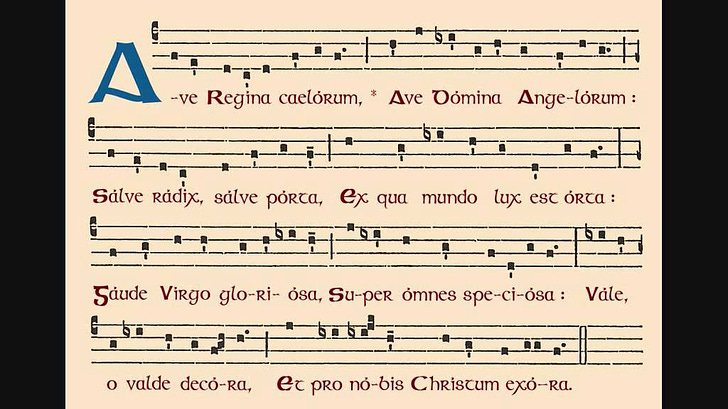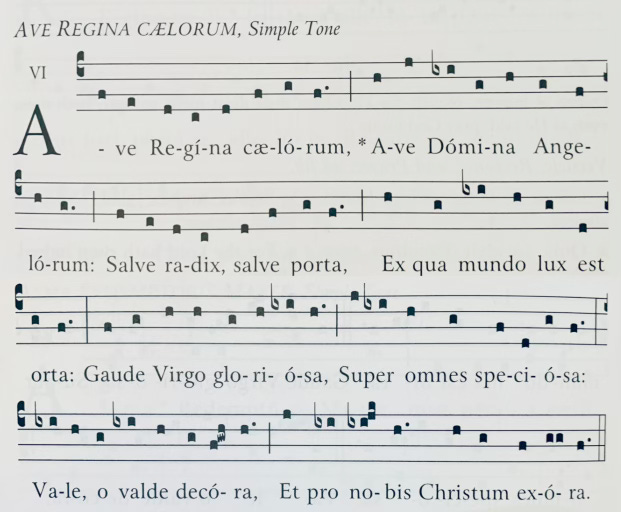The “Ave Regina Caelorum” is a Marian hymn assigned to the season of Lent; it’s commonly heard, and yet no one knows its origins.1
It was first recorded as a 12th century chant, and at the close of the medieval period, it began to be florally embellished by great composers, such as Dufay and Haydn.2
The chant ripples in a wave, building and swelling, echoing our knowledge that the spiritual darkness of Lent is building towards the already and eternally following feast of Easter and its joyous promise.
Hail, Queen of Heaven,
Hail, Lady of the Angels,
Hail, the root, hail, the gate!
From which the Light of the world arose:
Rejoice, glorious Virgin,
Lovely beyond all others.
Farewell, O most beautiful one,
And pray for us to Christ.
The words hail Our Lady as Queen of Heaven and of Angels, praising and glorifying her as the Mother and gateway to our salvation through her fiat, accepting Christ her King as her Son.
It must take a strange humility to accept one’s Lord, God, Creator, and King as one’s child to nourish, raise, protect and love as though He were fully human, while remembering His divinity.
And yet Mary could rejoice each time she looked upon His Holy Face, finding all the ancient promises and prophecies fulfilled - surely a rushing spring of holy joy and love, which is felt here in this chant, voiced by her children through the ages.
As the chant closes, there is an almost giddy, tearful cry to be sensed in the overflowing “Vále, O valde decóra” in which the original usage for the feast of the Assumption is echoed: “Farewell, o most beautiful one, and pray for us to Christ!”
We remind Our Lady of her joy, despite the coming of her unfathomable sorrows on Good Friday, and of the love and life she helped God to bring back into the world.
The titles of Our Lady herein honoured are of special import during Lententide. They remind us of the promise of the Redeemer fulfilled in the Incarnation, for she is the “glorious Virgin, beautiful above all. . . from whom the Light of the World arose.”
As Queen of Heaven, she reminds of her power of intercession, first and powerfully proven at the wedding in Cana, encouraging us to rely on her to pray for and watch over us. In our struggles with ourselves this Lent, we have the most powerful Mother’s love to keep drawing us to Christ.
As Queen of the Angels, she is ever willing to send them, as many as necessary, to aid us; to comfort us in our dark nights of the soul, and our experiences of the sharing in Christ’s agony in the Garden.
We are reminded of hope, strength, and joy; of the bloom of the seed that has died in the earth, as we die with Christ. We are encouraged to pass through this valley of tears into the vale of hope where our souls must reside.
We are given our most loving intercessor, our own Mother of all Mothers, Queen of Queens, who will be here even when we don’t notice, even when we forget to ask, and we are given the thousands of intercessors who are her angelic children.
With this army of love surrounding us, let us look forward to Easter even in our suffering as we sing, “Ave Regina Caelorum!”
You can enjoy a recording of the Ave Regina here:
Thank you for reading this guest post by Thérèse Judeana. To read more of her work, please visit her wonderful website, Windflower, where she writes about fiction writing, the arts, and Catholic fashion.
Articles Referenced:
Beauty So Ancient. “Ave Regina Caelorum in Latin and English.” Beauty So Ancient, 12 Feb. 2020, https://www.beautysoancient.com/ave-regina-caelorum-in-latin-english.
Henry, Hugh. "Ave Regina." The Catholic Encyclopedia. Vol. 2. New York: Robert Appleton Company,1907. <http://www.newadvent.org/cathen/02149b.htm>.
University of Dayton. “Antiphons.” University of Dayton. https://udayton.edu/imri/mary/a/antiphons.php.
University of Dayton. “Antiphons.” University of Dayton. https://udayton.edu/imri/mary/a/antiphons.php
University of Dayton. “Antiphons.” University of Dayton. https://udayton.edu/imri/mary/a/antiphons.php






